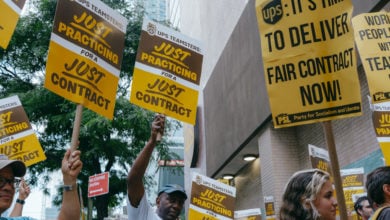Photo: Striking Maximus worker with her sons. Credit — @CWAUnion
On May 23, over 100 call center workers for Maximus Federal in Hattiesburg, Mississippi and Bogalusa, Louisiana launched a two-day strike. With the support of the Communications Workers of America (CWA), workers demanded affordable healthcare and livable wages from Maximus, the nation’s largest federal contractor of digital services with over 10,000 workers across 11 call centers in the United States. According to Frances Poole, one of the lead workers on strike, workers at Maximus Federal have worse health benefits than the callers they help with questions about Medicare and Affordable Care Marketplace. In fact, Frances herself says she is still rationing medication from 2019 due the obscene costs of healthcare as a Maximus worker.
Earlier this month Maximus reported a revenue increase of 22.7% and anticipates over $4.5 billion in revenue for the latest fiscal year. Amidst this windfall revenue, Maximus CEO Bruce Caswell makes well over 200 times the pay of his average employee.
In fact most of the workers involved in the strike were making between $9 and $11 dollars an hour before the pandemic and saw their wages raised to $15 only after a presidential order was set to raise federal contract workers to a new minimum. Additionally, Maximus actually lowered their healthcare deductibles from $4,500 to $2,500 following organizing pressure from the workers in early 2021, but it hasn’t been enough to quell the workers’ complaints. Poole asked indignantly “who has $2,500?”
The strike comes after years of efforts by the CWA to organize call center workers under the umbrella of Call Center Workers United. Earlier this year in March, workers at Maximus went on strike over complaints about poverty wages and poor benefits. Shortly after their previous strike ended, Maximus announced increases to worker pay.
However, amid drastically rising costs of living workers were not satisfied with the paltry pay raises offered by the company. Speaking to the history of bad pay at Maximus, a former worker Jaimie Brown who recently filed a complaint against the company asked “What man or woman or family can survive at $9.05 an hour … seven years I’d been doing this.”
Due to the high turnover of workers leaving call center jobs and a hostile anti-union legal environment in the South where most of these call centers are based, workers face an uphill battle. The workforce is predominantly composed of Black women and single mothers struggling to make ends meet, but when asked about why she took action striker Christina Jimenez said “As a mom of three, it’s really important to show my kids that no matter how small you are, you do have a voice. And so today I’m leading by example.”
Despite the challenges they face, call center workers continue to struggle in the heart of these contractors that underpin massive government agencies and services that millions of people rely on daily. These workers play a critical role in public services infrastructure and building power there could have large impacts far beyond their workforce.
On May 25, workers began returning to work after the two days on strike. Over the course of the action, workers saw an outpouring of support from over 10,000+ community members who signed on to a solidarity petition. Despite their energy, the company refused to meet with the strikers or their union representatives, instead opting to host a virtual board meeting and later making a statement that Maximus “routinely meets with its employees to address various concerns and issues.” But the workers remain committed to holding Maximus accountable to its promises of improvements. Call Center Workers United is continuing with determination to organize workers in major federal contractors in the deep south.






